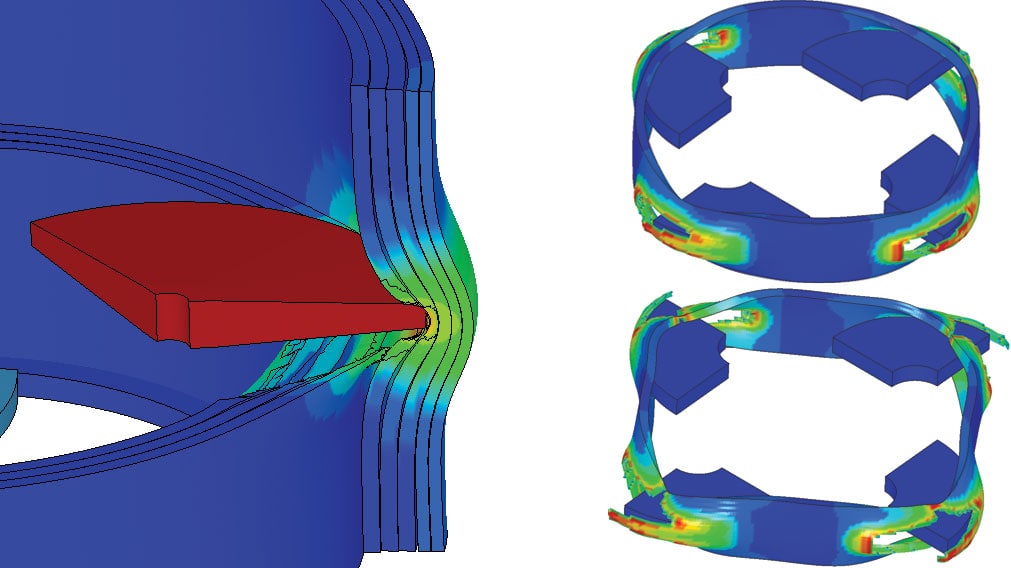Containment Analysis: Rigorous Planning for Safety
October 1, 2012
Because of the large rotational energy in high-speed rotating components, there is an inherent risk of damaging bursts – whether planned or not. To conduct safe and successful burst testing, several aspects of material behavior must be well understood to create an effective machine design. However, machine design is only the first step, and must be combined with prudent test methods.
 The surrounding images represent burst fragments colliding with rigs’ containment walls. Bursts can happen in a number of potentially destructive ways, and Test Devices designs and builds its machines with all possibilities in mind.
The surrounding images represent burst fragments colliding with rigs’ containment walls. Bursts can happen in a number of potentially destructive ways, and Test Devices designs and builds its machines with all possibilities in mind.The company works diligently to provide the safest equipment possible.
Test Devices’ engineers consider all aspects of possible damage as they design spin test chambers to prevent hardware fragments from escaping the test machine and causing damage. Containing a burst of a high-speed rotating component such as an engine rotor is equivalent to containing explosives. For example, a single fan blade on a large commercial aircraft engine has enough energy to lift a London double-decker bus more than 60 feet in the air! And the rotor or disk supporting the blade has 20 times more energy than the airfoil. “One can imagine how much damage it can cause in the event of disk burst, so we’re very serious about designing a structure that can contain it safely and conducting tests without destroying equipment or inflicting bodily harm,” Hiro Endo, Vice President of Engineering, said.
When designing equipment, Test Devices’ engineers consider worst-case scenarios to determine the required containment or armor liner thickness. This includes FEA modeling and analysis to determine the way components fail and the failure mechanisms resulting from these conditions. “Historically, the tri-hub burst has been the standard used to calculate radial burst energy, but it is surprising how infrequently this failure mode occurs in the many tests we perform in our facilities,” stated Eric Sonnichsen, Test Devices Founder. This is why the company’s engineers consider other factors from parts’ potential for fragmentation (size, shape and speed) and explosiveness to their behavior at high spin speeds.
During burst testing, fragments can easily pierce through even strong material such as high-strength steel. Fragments also have the potential to burst axially or through machine covers, presenting a variety of dangerous, destructive scenarios. Often, disks break into complex shapes and can deform the containment shell through scabbing, penetration, perforation, shearing, fracture, or piercing.
Test Devices stores a vast amount of data collected from past tests. This information, together with published impact and penetration data, are the basis for Test Devices’ detailed modeling and predictive analysis efforts. “We have developed a fundamental understanding of burst containment. While we need to provide cost-competitive testing machines, human safety remains the primary criterion in the design of TDI spin test machines,” said Sonnichsen. “Our efforts have given us a better understanding of burst containment, a method for the analysis of specific burst scenarios and validation of our design practices.” Tri-hub bursts are not as simple or common as generally believed. Spin-test equipment often lasts 30 to 40 years, so machines live to see previously unimagined part sizes and testing speeds. Any machine testing high-energy components must be designed for all eventual uses and be part of a safe plant layout.
There are several myths about containment that are prevalent in the industry. The first myth is about energy limitation: the assumption that containment can be rated for a maximum energy of burst, and therefore, any rotor that bursts at or below that limit will be contained. Test Devices’ analysis and experience show that rotor energy is only a crude measure of the hazard presented by a burst. The shape of the fragments and their orientation are very important, Sonnichsen said.
“Another inaccurate belief states that multiple thinner walls spaced apart from one another are more effective than a single wall of equivalent thickness,” Sonnichsen added. The company’s analysis and experience show that a single-thickness wall is much better able to contain fragments because more of the material participates in the initial impact and the outer portion of the wall reinforces the inner portion.
Lastly, the belief that the main concern for bursting is radial leads to the presumption that safety concerns can be mitigated by installing machines in the ground. When fragments impact the containment, they can be redirected axially with very high force. Soft inner liners designed to cushion the impact and preserve fragments are particularly dangerous in this regard. There are reports of multiple accidents involving the ejection of the machine cover with destructive escape of high-energy fragments as a consequence.
Design of robust containment structures and machine features is only the first step in preventing test accidents. The test must be engineered to avoid refocusing impact energy in the axial direction. Instrument connections into the test chamber must be designed to prevent loss of vacuum. High-energy rotors must not be tested with inadequate containment. These scenarios, and other potentially dangerous ones, must be considered for every test.
“As a testimony to our expertise, Test Devices has successfully demonstrated containment through the testing of major gas turbine engines’ biggest disks,” Endo said.
“We can confidently say our containment system is proven and has repeatedly demonstrated its reliability.” Test Devices’ spin test machines also incorporate proprietary materials and design elements that separate their level of containment from the competition. “Our methods are evolving all the time,” Endo stated.
Design of a strong containment system is, of course, the first step in preventing test accidents.

